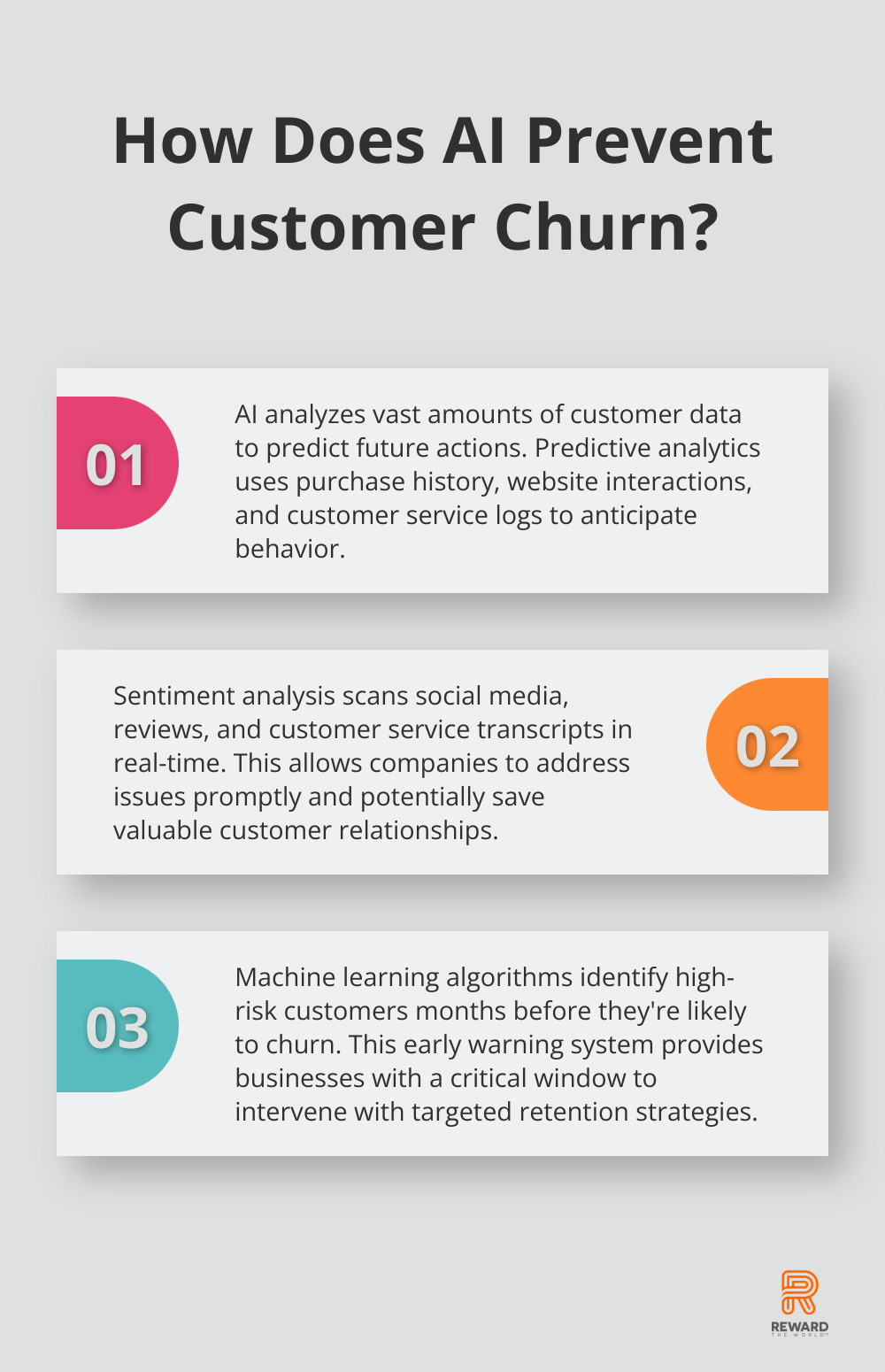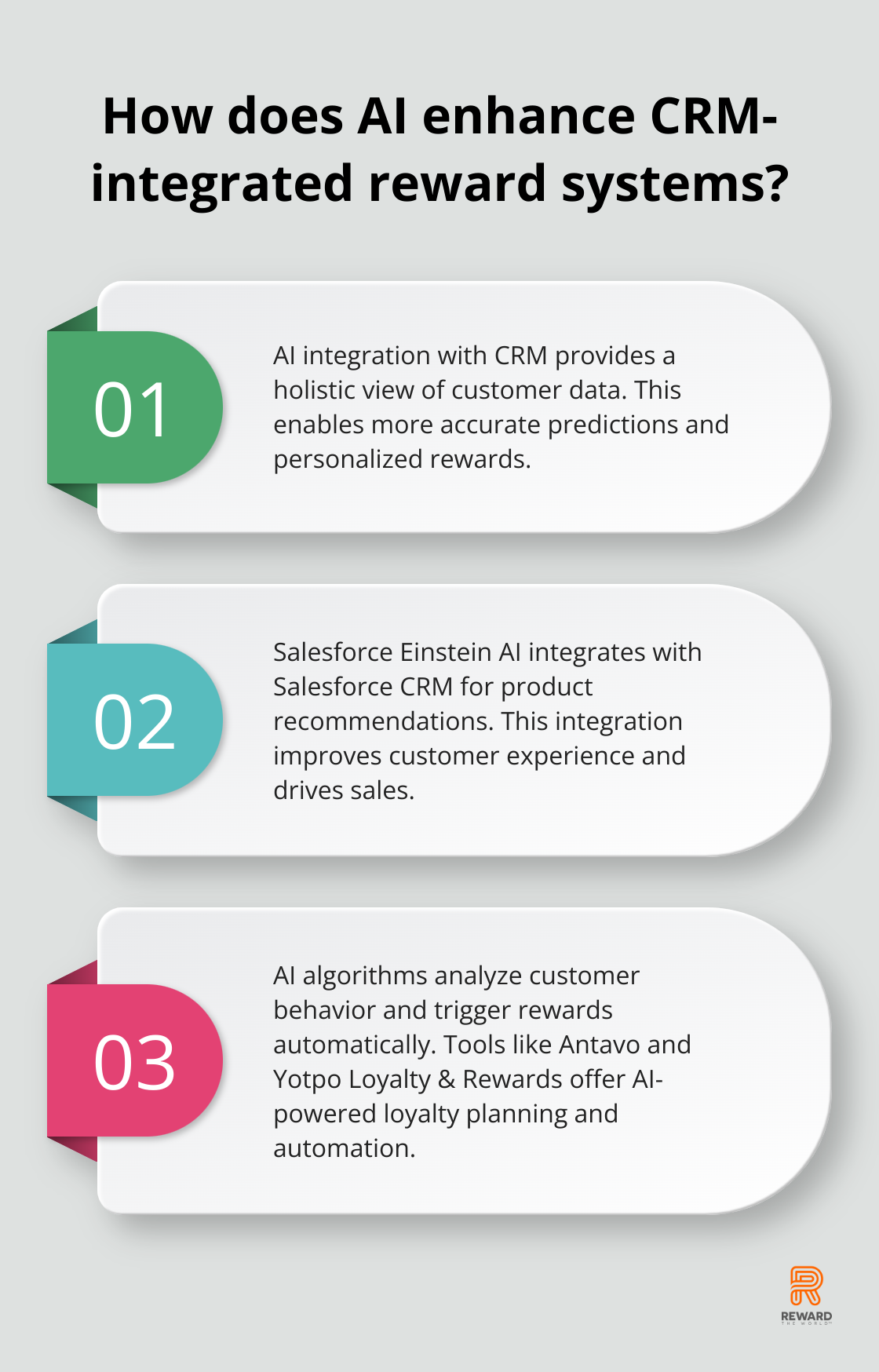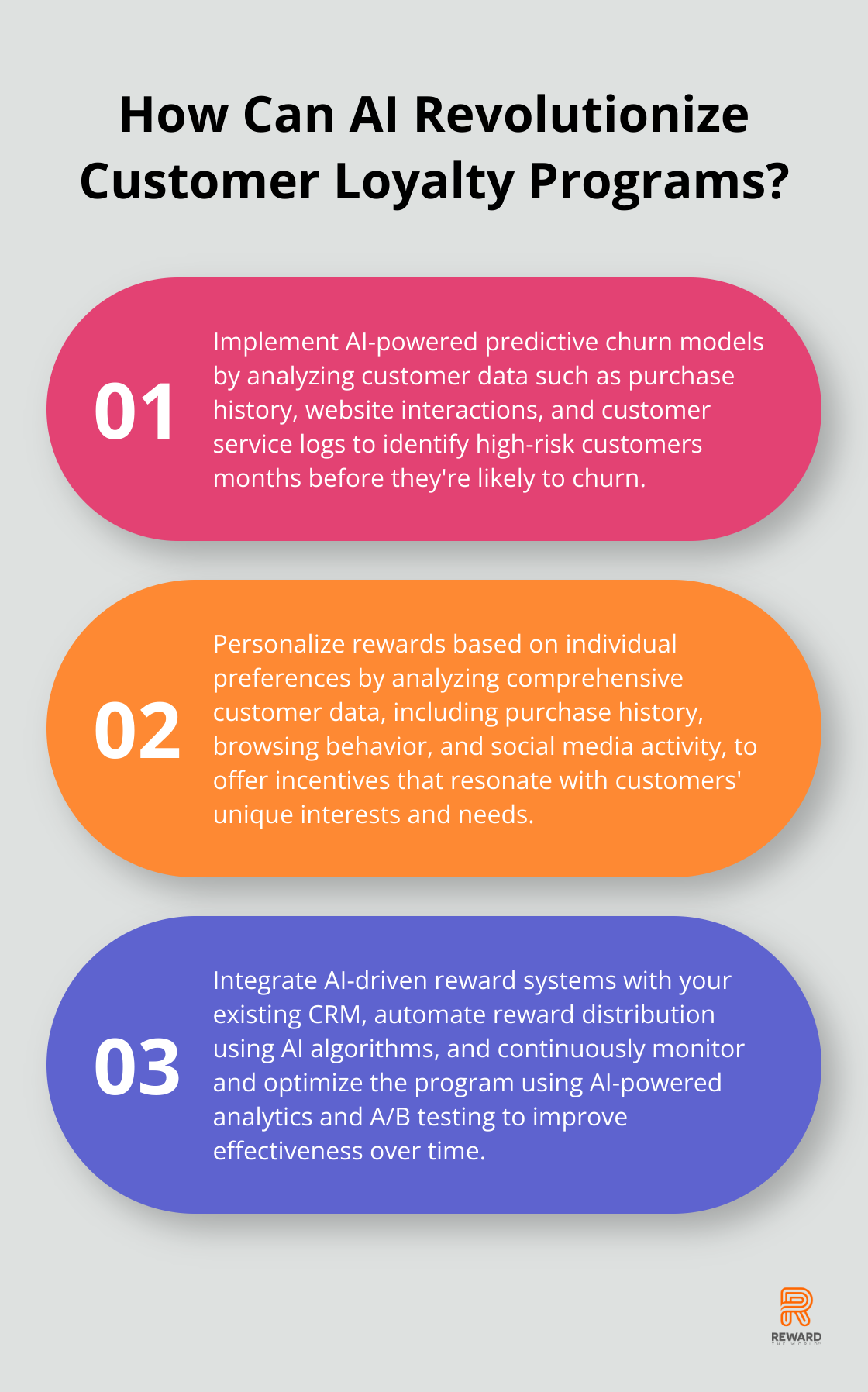
At Reward the World, we’re constantly exploring innovative ways to keep customers engaged and loyal. The rise of artificial intelligence has opened up new possibilities for preventing customer defection through timely, personalized rewards.
Predictive churn models, powered by AI, are revolutionizing how businesses anticipate and address customer attrition. In this post, we’ll explore how these advanced technologies can be harnessed to create effective reward strategies that boost retention and drive long-term customer value.
How AI Predicts and Prevents Customer Churn
Decoding Customer Behavior with AI
AI transforms customer retention strategies at an unprecedented scale. Predictive analytics now allows businesses to anticipate customer behavior with remarkable accuracy. AI systems excel at identifying subtle patterns in customer data that humans often overlook. These systems analyze vast amounts of data (purchase history, website interactions, customer service logs) to predict future actions.
Sentiment analysis stands out as a powerful application. AI tools scan social media posts, reviews, and customer service transcripts to gauge customer satisfaction in real-time. This capability enables companies to address issues promptly, potentially saving valuable customer relationships.
Machine Learning Revolutionizes Churn Prediction
Machine learning algorithms have transformed churn prediction. These models improve their accuracy over time as they learn from new data. A recent study introduced explainer models to provide both local and global explanations of churn predictions.

These algorithms identify high-risk customers months before they’re likely to churn. This early warning system provides businesses with a critical window to intervene with targeted retention strategies.
Real-time Decision Making: The Game Changer
The true power of AI in customer retention lies in its ability to process data and make decisions instantly. This capability allows businesses to deliver personalized experiences at scale.
An e-commerce platform might use AI to detect when a customer is about to abandon their cart. The system could instantly trigger a personalized offer, potentially saving the sale. Netflix employs a similar approach, with AI algorithms constantly adjusting recommendations based on viewing behavior.
Balancing AI and Human Touch
While AI offers powerful tools for customer retention, technology alone doesn’t suffice. Successful implementation requires a deep understanding of customers and a commitment to delivering value. When used effectively, AI helps businesses create more meaningful, personalized experiences that keep customers coming back.
As we move forward, it’s essential to consider how these AI-driven insights translate into effective reward strategies. The next section will explore how businesses can design and implement reward programs that leverage AI’s predictive power to maximize customer retention.
How to Craft Reward Strategies That Work
Personalize Incentives Based on Individual Preferences
Modern consumers expect personalized experiences. A study by Epsilon found that when brands personalize the shopping experience, consumers are 80% more likely to make a purchase. To create truly personalized incentives, businesses must analyze customer data comprehensively. This includes purchase history, browsing behavior, and even social media activity.

For instance, a frequent traveler might appreciate airline miles or hotel points (aligning with their lifestyle), while a busy parent might value meal delivery services or childcare vouchers (addressing their specific needs). The key is to offer choices that resonate with your customers’ unique interests and preferences.
Optimize Timing and Frequency of Rewards
The timing of rewards can make or break their effectiveness. Too frequent rewards risk devaluation, while infrequent ones might miss critical opportunities to prevent churn. AI can help identify optimal moments to offer rewards. For example, Kognitiv Pulse, an AI-powered insights and activation tool, can detect changes in customer lifecycle and predict churn with 95%+ accuracy.
Frequency should also be tailored to individual customer behavior. High-value customers might warrant more frequent rewards, while occasional buyers might receive less frequent, but higher-value incentives.
Balance Short-term Gains with Long-term Loyalty
While immediate rewards can drive quick wins, building a program that fosters long-term loyalty is essential. Bain’s Loyalty Insights provide research and knowledge to help companies earn their customers’ advocacy.
A tiered reward system can encourage ongoing engagement. Entry-level rewards might be small but frequent, while higher tiers offer more substantial benefits. This approach motivates customers to stick around and climb the loyalty ladder.
Another effective strategy offers rewards that compound over time. A coffee shop might offer a free drink after ten purchases, but also provide a bonus reward for customers who reach this milestone three months in a row.
The goal is to create a reward program that not only prevents immediate defection but also builds a lasting emotional connection with your brand. AI insights can power these strategies, keeping customers engaged and loyal over the long term.
As we move forward, it’s important to consider how these reward strategies can be implemented effectively using AI-driven systems. The next section will explore the practical aspects of integrating these strategies into existing business operations and maximizing their impact through automation and continuous optimization.
How to Implement AI-Driven Reward Systems
Seamless Integration with CRM Systems
The first step to implement an AI-driven reward system is to integrate it with your existing Customer Relationship Management (CRM) system. This integration provides a holistic view of customer data, which enables more accurate predictions and personalized rewards.
Salesforce Einstein AI integrates with Salesforce CRM, allowing you to create product or order recommendations. This integration can help companies improve their customer experience and drive sales.

To ensure successful integration:
- Audit your current CRM data
- Clean and standardize your data for accuracy
- Choose an AI solution compatible with your CRM
Many CRM providers now offer built-in AI capabilities, which simplifies the integration process.
Automating Reward Distribution
After integration, the next step is to automate reward distribution. AI excels here, enabling real-time, personalized rewards at scale.
AI algorithms analyze customer behavior and trigger rewards automatically. For example, tools like Antavo offer AI-powered loyalty planning and real-time program adjustments, while Yotpo Loyalty & Rewards simplifies segmentation and automates reward campaigns.
To implement this:
- Define clear rules for reward distribution based on customer segments and behaviors
- Use AI to refine these rules continuously based on their effectiveness
Continuous Monitoring and Optimization
The implementation of an AI-driven reward system requires ongoing monitoring and optimization for long-term success.
Use AI-powered analytics to track key metrics such as redemption rates, customer lifetime value, and overall program ROI. These insights help you identify what works and what needs improvement.
If certain rewards have low redemption rates, AI can suggest alternative rewards that might appeal more based on customer data.
Regular A/B testing is essential. Use AI to segment your customers and test different reward strategies. This approach can lead to significant improvements. AI in retail can help retailers improve their demand estimates, make better pricing decisions, and optimize product placement.
The goal is to create a dynamic, responsive reward system that evolves with your customers’ preferences. AI-driven integration, automation, and optimization can create a reward program that not only prevents customer defection but also drives long-term loyalty and business growth.
Final Thoughts
AI has revolutionized customer retention strategies through predictive churn models. These models analyze vast amounts of customer data to identify subtle patterns that signal potential defection. AI enables real-time decision-making, allowing businesses to deliver personalized experiences and timely rewards at scale.

We expect AI-driven customer loyalty programs to become increasingly sophisticated. Advanced machine learning algorithms will enable more accurate churn predictions, while natural language processing will enhance personalized communication. AI systems will likely develop greater emotional intelligence, allowing for a more nuanced understanding of customer sentiment and motivation.
Reward the World offers businesses a powerful tool to implement AI-driven retention strategies effectively. With its global reach, instant reward delivery, and robust analytics, our platform stands at the forefront of this revolution. The future of customer loyalty lies in the intelligent application of AI to create lasting relationships and drive long-term growth.
